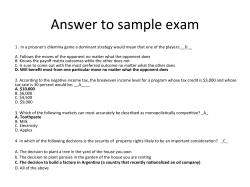
HW9 - Washington State University
EconS 301, Spring 2015, Dr. Rosenman Homework 9 1. One measure of market power is called Lerner’s Index which is given by the formula LI=(P-MC)/P. Explain how elastic demand minimizes the market power of a firm. (Hint: use the profit maximizing rule for setting output). (2 points) 2. A local town wants to raise more tax revenues. It is considering two taxes. One tax would be imposed on local cable television, which has a monopoly. The other tax is on gasoline, which is sold in a competitive market environment. An economist testifies that consumers would pay all the tax on gasoline, but the cable television company would share part of that tax. But gasoline station owners say their competitive market would force them to absorb the tax, while the monopoly cable television company plans to just pass the tax on to its customers. Who is correct, and why? In each case, discuss what would happen to profits for the firm or firms in the industry. (4 points) 3. In 1984 in what may its most famous anti-trust action, the Department of Justice forced AT&T to give up its monopoly on local and long-distance phone service and the market moved from being a monopoly to one of competition – in some sense, with new phone service available through the internet and with cell phones, phone service is now close to a perfect competition. Using graphs, contrast the following aspects of phone service under the AT&T monopoly and the current competitive system: a. The price consumers pay and the quantity of service they use (2 point) b. Consumer surplus and producer surplus (1 point) c. The cost of producing phone services (1 point) 4. In the 1990s Gritman Memorial Hospital (GMH) in Moscow and Pullman Regional Hospital (PRH) discussed a merger. Part of the motivation was that it is generally thought that the MoscowPullman area is a single market for hospital care. Some local residents in Pullman worried that it would create a monopoly for hospital services, and because wages, and thus costs, are lower in Moscow, a merger would mean PRH would close and GMH would be the only hospital in the area. a. Using the idea of a multiplant monopolist, explain why we might expect after a merger the monopoly firm would keep both hospitals operating if demand is large relative to the efficient size of a hospital (2 points) b. Suppose instead the demand in each town is small relative to the efficient size of a hospital. Would we then expect the monopoly to keep both hospitals open? (2 points) 5. Most movie theatres offer a “senior price” to customers over the age of 60 or 62. Using the rule for mark-up of price over marginal cost, explain how this tells us that the demand for movies by seniors is more elastic than the demand for movies by non-seniors. (2 points) 6. Most grocers offer “value packs” in their meat departments. This is a form of price discrimination. Explain what type it is, and using graphs explain how it can increase both the profit the grocer makes and consumer surplus. To make your graph easier, assume MC is constant. (3 points) 7. Avista, the company that supplies electrical power to most of eastern Washington, is a natural monopoly. According to the Washington State Utilities and Transportation Commission (WSUTC) , which must approve the prices Avista charges, the goal is “to ensure regulated companies provide safe and reliable service to customers at reasonable rates, while allowing them the opportunity to earn a fair profit.” Recently Avista announced large salary increases for many of its top executives. Assume “a fair profit” means a normal rate of return. Using graphs, explain: a. That monopolies regulated according to the goals of the WSUTC have little incentive to control costs, and thus we should expect to see high salaries and possibly overinvestment in capital. (2 points) b. The result of the regulatory goal could be less electrical usage. (1 point) 8. Suppose United Airlines has a monopoly on the route between Chicago and Omaha. During the winter the monthly demand is given by P=a1-bQ. During the summer the monthly demand is given by P=a2-bQ where a2>a1. Assume the MC is the same in the summer and winter. Will United charge a higher price in the summer or winter? Explain. (3 points) XC1: A perfect competition can produce a good at a constant marginal cost of $10 per unit. Monopolized, the industry can still produce at a cost of $10 per unit, but also must pay lobbying costs of $2 per unit to keep the monopoly. The market demand is given by Qd=1000-5P a. Calculate the output, price and profit under perfect competition and monopoly. (2 points) a. Calculate the loss in consumer surplus and producer surplus from monopolization. Where did it go? (2 points) b. Suppose the monopoly firm is able to be a perfect price discriminator. What will its profit be? What will be the price of the last unit sold? What will happen to consumer surplus? (1 point) XC2: In a monopoly market the inverse market demand curve given by P=968-20Q. The firm has two plants. At one modern plant the cost of production MC1=8 for any number of units produced at plant 1 (MC is constant). The other, older plant faces a MC given by the formula MC2=1+0.5Q2 where Q2 is the amount produced at plant 2. a. Find the profit-maximizing price and quantity for this market. (2 point) b. How will the firm allocate production across the 2 plants? (2 points) c. If the MC in the modern plant goes up to 10, what would be the new answers to parts a and b? (1 point)
© Copyright 2025











